This post is the eighth in our series about myFutureNC’s Bite-Sized Webinars. Previous posts covered Family-Sustaining Wages, Labor Market Alignment, FAFSA and Financial Aid, NC Pre-K, Opportunities for Growth, Opportunity Youth, and Career and College Promise (CCP).
Students Can Get a Head Start on Their Careers through the Career and Technical Education (CTE) Program
The topic for the eighth Bite-Sized Webinar from myFutureNC focused was the Career and Technical Education (CTE) program for high school students. In this post we will be summarizing the webinar and also exploring our region’s CTE data using the attainment profile for the Land of Sky region and for the four individual counties our region comprises: Buncombe, Henderson, Madison, and Transylvania. This webinar contained an overview of the CTE program in NC, provided some summary statistics, presented some strategies for strengthening CTE in the state, and included some promising practices from Martin County Schools.
The Northeast Region’s Regional Impact Manager for myFutureNC, Angie Jenkins, facilitated this Bite-Sized Webinar on May 21, 2024. Ms. Jenkins drew the audience’s attention to the CTE statistics at the bottom of the attainment profile: students in North Carolina completed 325,307 Career and Technical Education (CTE) credentials (65,583 [20%] were industry-valued credentials) and 67,142 concentrations in 2023. The top three CTE concentrations completed include Health Science; Human Services; and Agricultural, Food, and Natural Resources.
According to the 2024 attainment profile for the Land of Sky region (relevant section shown below with the CTE data outlined in red), students in the Land of Sky region completed 6,109 Career and Technical Education (CTE) credentials (1,650 [27%] were industry-valued credentials) and 2,457 concentrations. The top three CTE concentrations completed include Human Services; Agricultural, Food, & Natural Resources; and Hospitality & Tourism. A related data point (outlined in orange in the image below) pertains to participation by our region’s students in the Career and College Promise (CCP) program, which was the focus of the previous webinar (read that post here).
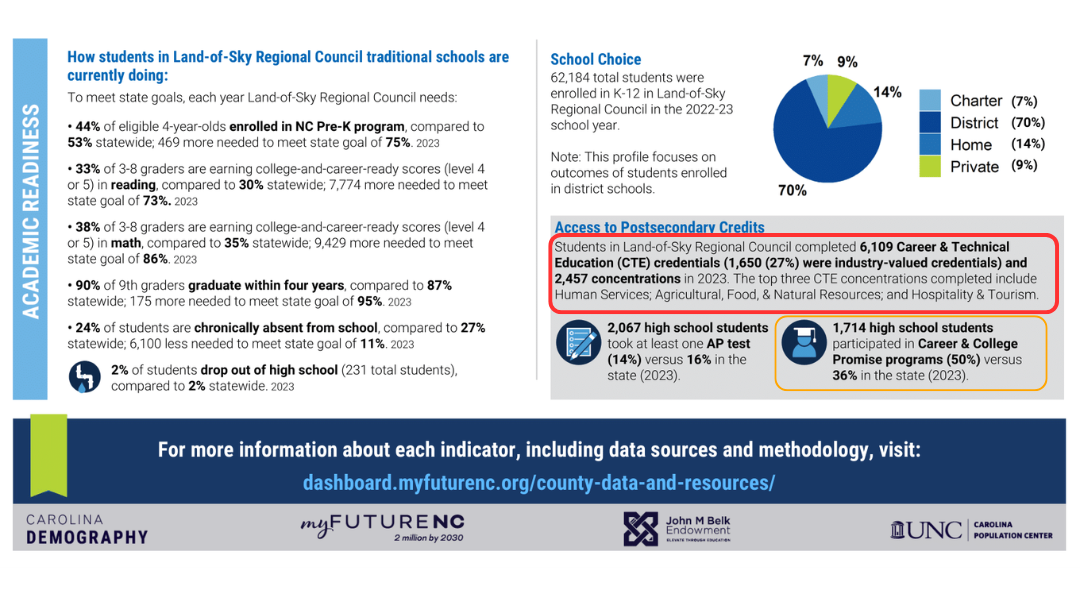
Overview of the Career and Technical Education (CTE) Program in North Carolina
Dr. Nancy Cross, Assistant Director for CTE Regional Services and Reporting for the North Carolina Department of Public Instruction (NCDPI), presented an overview of the CTE program in North Carolina. She began by sharing data about the opportunities available to students through CTE and the associated attainment figures. CTE opportunities are available in all 115 school districts across the state. In addition to the 70 state-supported career pathways, approximately 150 local options are also available that are specific to a district’s labor market needs. Dr. Cross emphasized that CTE students outperform non-CTE students in:
- On-time graduation rates
- Postsecondary placement rates
- Academic proficiency
- Credential attainment
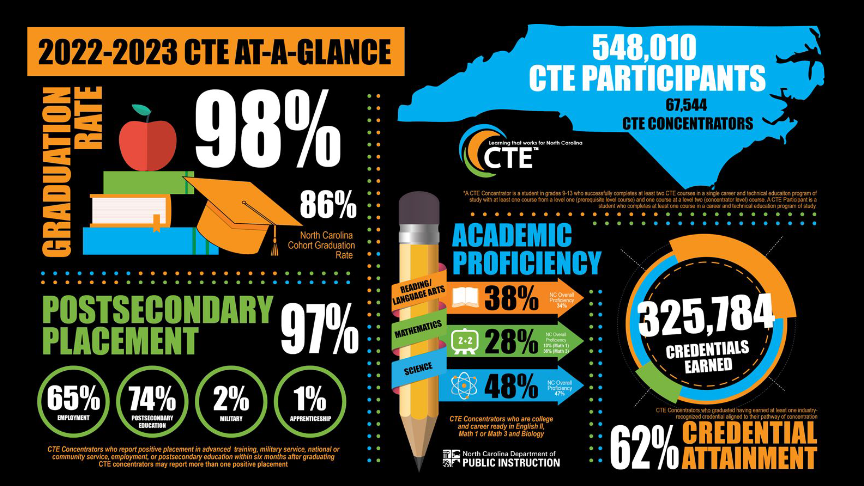
Next, she shared some strategies to strengthen the CTE program in NC, including continuing to offer programs aligned with labor market needs. Another strategy is the new Career Development Plan requirement, which will enable CTE departments to work with elementary school students in addition to middle and high school students. She also discussed the need to expand work-based learning and dual-enrollment opportunities. She finished by stressing the need to raise awareness about CTE options and outcomes.
Promising Practices for Increasing Participation in CCP
The promising practices section of this webinar featured Kristy Christenberry, Curriculum Instructional Management / Special Populations Coordinator, and Jason Wynne, Career Development Coordinator, both from Martin County Schools. In their short presentation, Ms. Christenberry and Mr. Wynne shared a document they called “pathways to success” that describes the eight different CTE pathways available to students in that school district. Even though the district already offered more CTE pathways than other school districts in their area, Martin County Schools still wanted to expand their offerings. To do so, Ms. Christenberry and Mr. Wynne explained, required them to obtain funding in the form of grants from different sources to fund the new pathways. Next, they discussed the importance of internships, including in departments within the school district so that transportation will not be a barrier to participation for students.
We love to see our students being productive in local businesses, and we want to provide every child every opportunity.
Lastly, they shared examples of some of their marketing materials aimed at students, parents, and community members to raise awareness and engagement with CTE.

Connection to Our 2030 Goals for Educational & Workforce Attainment
The Career and Technical Education (CTE) concentrations and credentials connect directly to our strategic goal for the workforce:

North Carolina’s CTE program provides opportunities for students to complete their pathway while still in high school and to graduate ready to enter the workforce with a valued credential. In this way, CTE directly supports our efforts to ensure that 90% of adults in the labor force obtain credentials that are needed by our region’s employers.
While we at the Land of Sky P20 Council do not have a specific strategic goal associated with CTE participation, we do have two key performance indicators (KPIs) that track this data because increasing CTE access and participation can increase high school graduation rates and credential attainment. We track the number of students who graduate with a credential (CTE is one of the pathways) and also the percentage of students cross-enrolled during K-12. The chart for cross-enrollment shows data for our region’s two community colleges, each of which serves two of our counties. That chart provides both the overall numbers of CCP participation and also subdivides this data to show how many of those students were in each pathway (CTE is one of the pathways).
CTE Concentration Completion Trends by County
The chart below shows trends in CTE concentration completions for each of our four counties using data from the last three attainment profiles from myFutureNC (from 2020, 2022, and 2024). Buncombe County data includes both Asheville City Schools and Buncombe County Schools.
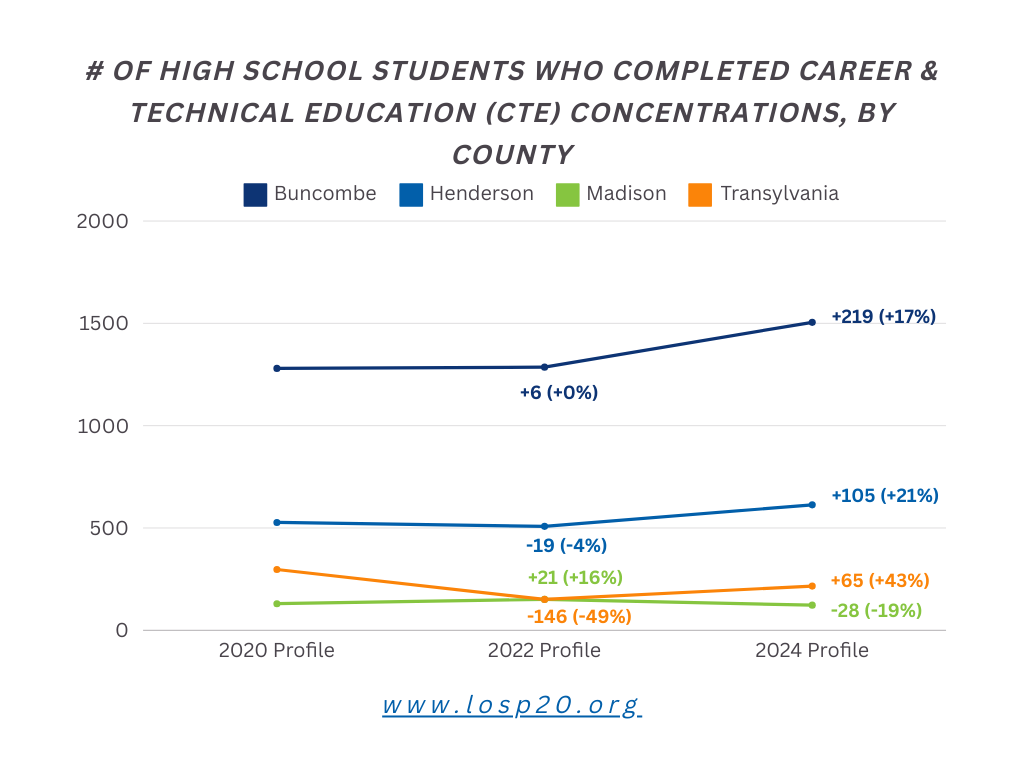
In Madison County, CTE concentration completion increased by 16% on the 2022 attainment profile compared to 2020, whereas Henderson and Transylvania both saw decreases (-4% and -49%, respectively), and Buncombe County’s rate remained flat. On the 2024 attainment profiles compared to the 2022 profiles, three counties (Buncombe, Henderson, and Transylvania) experienced increases in their CTE concentration completion rates (17%, 21%, and 43%, respectively). Madison County saw a decrease of 19% during this time period. Comparing the 2024 attainment profiles to the 2020 attainment profiles, both Buncombe and Henderson experienced net gains of 17%, while Madison and Transylvania had net losses in their CTE concentration completion rates of -3% and -6%, respectively.
CTE Credential Attainment Comparison by County per the 2024 Attainment Profiles
When we look at CTE credential attainment, rather than concentration completions, a different picture emerges. The chart below shows the number of students who completed CTE credentials from the 2024 attainment profiles for each of our four counties. Note that, as with the previous chart, Buncombe County data includes both Asheville City Schools and Buncombe County Schools.
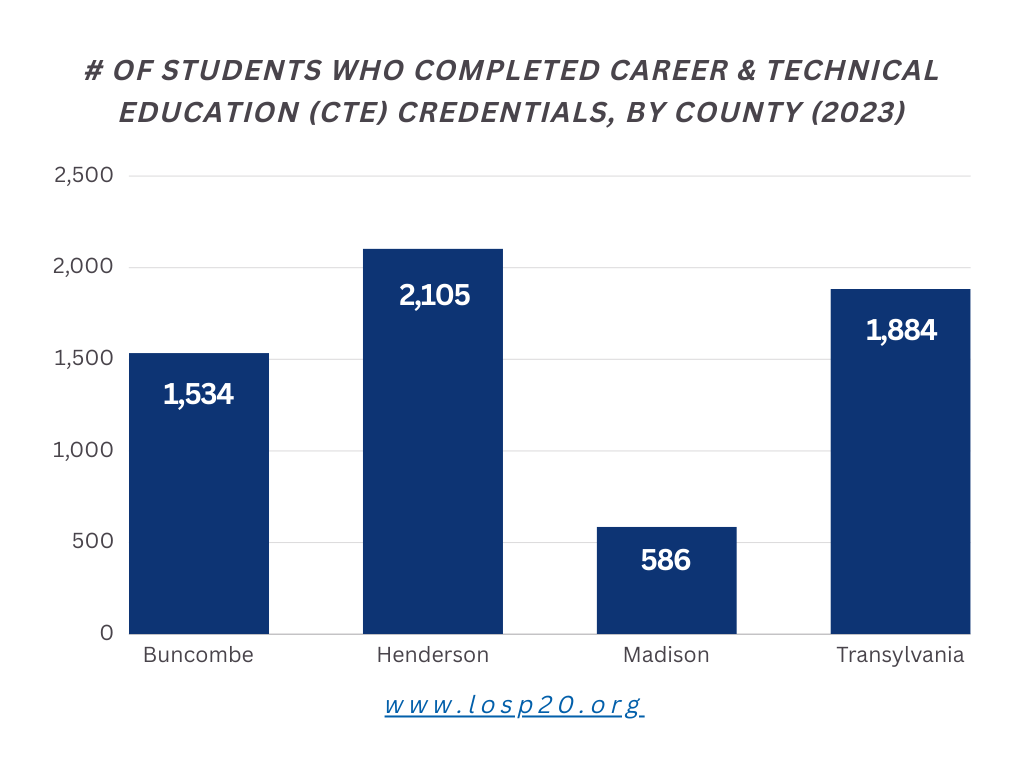
Henderson County Public Schools and Transylvania County Schools are both smaller districts than Buncombe County Schools (by itself, and certainly when combined with Asheville City Schools), yet Henderson and Transylvania each had higher numbers of students earn CTE credentials (2,105 and 1,884, respectively) than Buncombe did (1,534). Madison County had the fewest CTE credential completions (586).
Check out our data dashboard for dozens more charts like the ones above that track our progress toward our educational and workforce attainment goals.
Detailed CTE Data by County per the 2024 Attainment Profiles
Buncombe (suburban)
The 2024 attainment profile for Buncombe County states that students completed 1,534 CTE credentials (343 [22%] were industry-valued credentials) and 1,505 CTE concentrations in 2023. The top three CTE concentrations completed include Human Services; and Arts, Audio/Video Technology, & Communications; and Health Science.
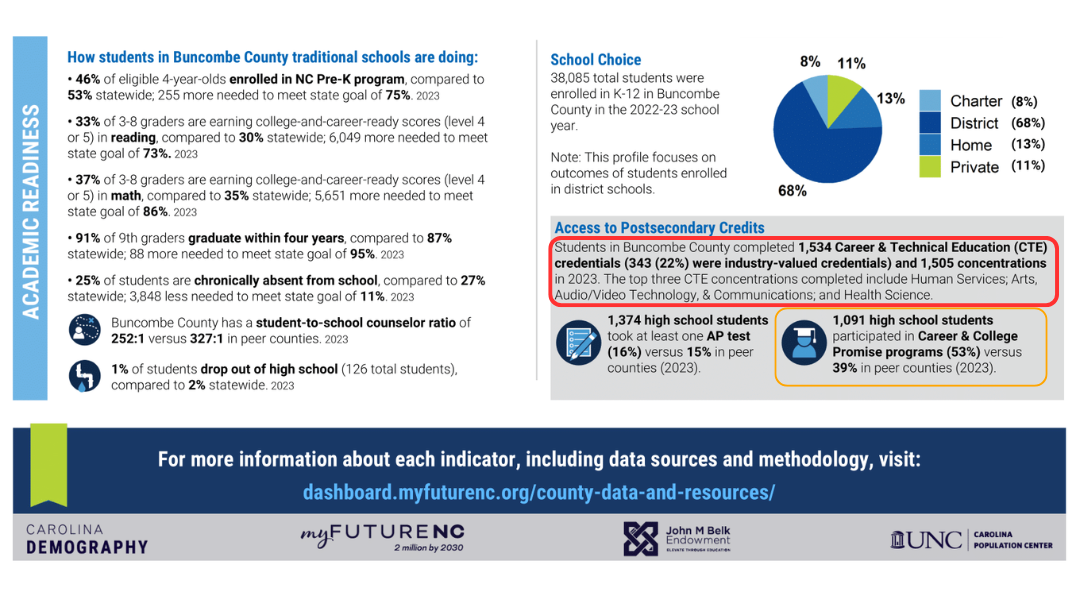
Henderson (suburban)
According to Henderson County’s 2024 attainment profile, students in the county completed 2,105 Career & Technical Education (CTE) credentials (766 [36%] were industry-valued credentials) and 613 concentrations in 2023. For this county, the top three CTE concentrations were Architecture and Construction, Manufacturing, and Health Science.
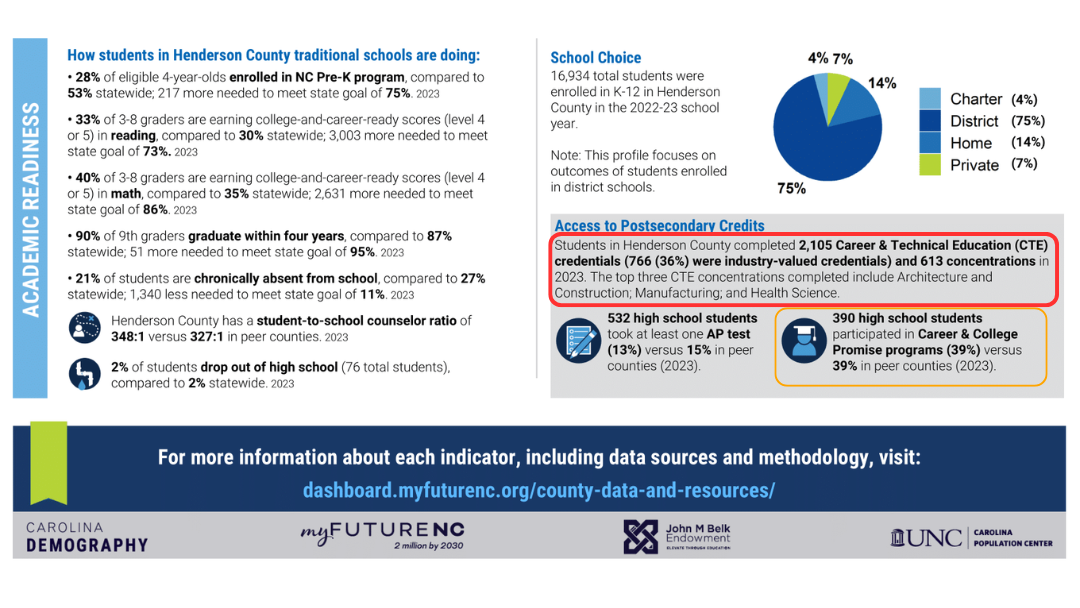
Madison (rural metro)
Madison County students completed 586 Career & Technical Education (CTE) credentials (171 [29%] were industry-valued credentials) and 123 concentrations in 2023, per their 2024 attainment profile. The top three CTE concentrations in this district were Human Services; Agriculture, Food, & Natural Resources; and Manufacturing.
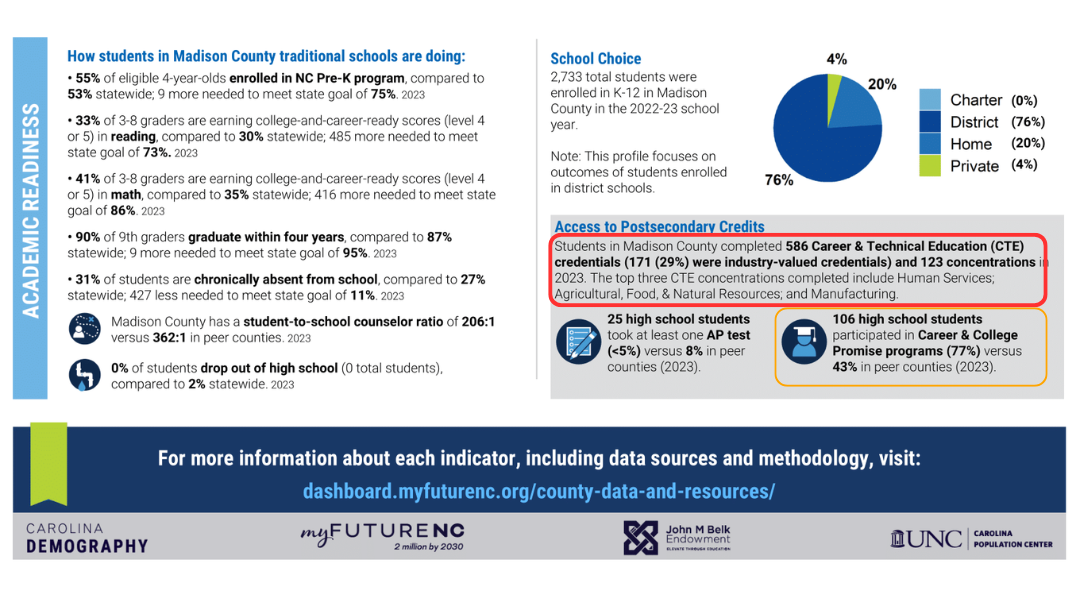
Transylvania (rural non-metro)
Transylvania County’s 2024 attainment profile indicates that students there completed 1,884 Career & Technical Education (CTE) credentials (370 [20%] were industry-valued credentials) and 216 concentrations in 2023. The top three CTE concentrations completed include Architecture and Construction; Agricultural, Food, & Natural Resources; and Hospitality & Tourism.
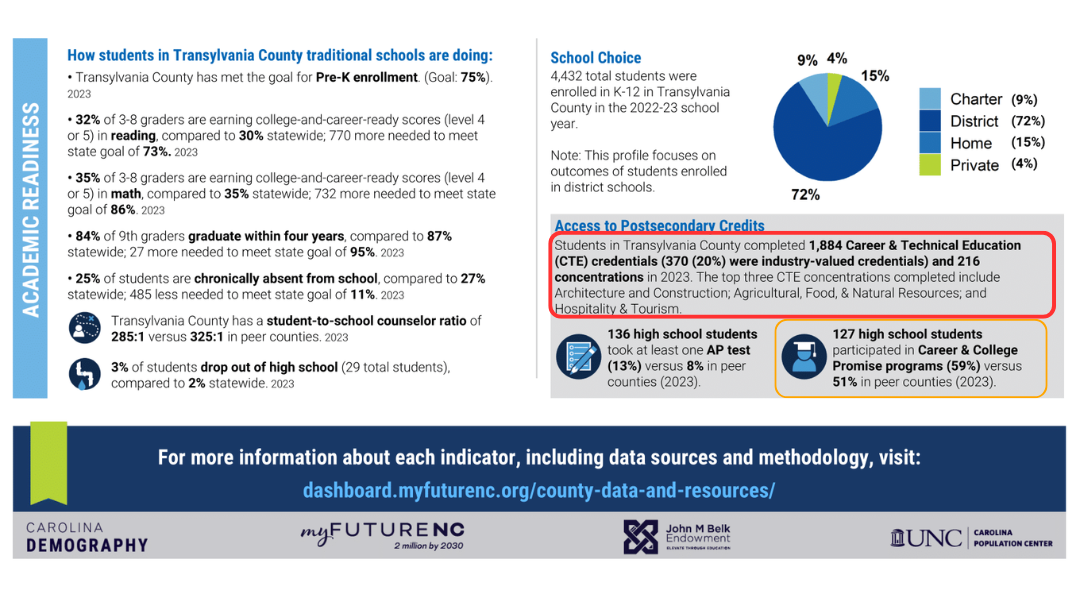
The top three CTE concentrations in each county give us some insight into both the similarities and differences in labor market needs in our region’s counties. For example, Architecture and Construction; Health Science; Human Services; Manufacturing; and Agriculture, Food, & Natural Resources were each one of the top three CTE concentrations in two counties, which suggests a similar need in the labor markets for these sectors in our region. Conversely, Arts, Audio/Video Technology, and Communications; and Hospitality & Tourism each only showed up in the top three list for a single county in our region, reflecting labor market needs unique to those counties. Both of our rural counties (Madison and Transylvania) had Agricultural, Food, and Natural Resources among their top three CTE concentrations, and both of our suburban counties (Buncombe and Henderson) had Health Science among their top three CTE concentrations.
Land of Sky P20 Council's Efforts To Increase CTE Involvement
Initiatives
We have worked closely with CTE Directors from three counties in our region (Buncombe, Henderson, and Transylvania) on our #worklocal campaigns. Each campaign highlights local graduates who work at local employers in high-growth, high-demand industries to encourage local high school students to seek training and employment opportunities within growing career fields that align with the local labor market.
Policy Advocacy
We have policies in both the K-12 Education and Credentials & Workforce sections of our legislative agenda that pertain generally to Career and College Promise (CCP), which includes CTE as one of its three pathways, and we also advocate for several associated strategies that apply to CCP, and therefore to CTE, specifically.
K-12 Education policy recommendation: Provide school districts with greater policy and legal flexibility to facilitate greater alignment to local and regional needs.
Strategies specific to CCP (and CTE):
- Revise legislation to allow schools to align their schedules with their local community college to enable students to participate fully in the Career and College Promise program and take tuition-free college courses while in high school.
Credentials & Workforce policy recommendation: Expand and strengthen coordination between K-12 and higher education to promote postsecondary pathways leading to recognized credentials leading to high-demand jobs with sustainable salaries and benefits.
Strategies specific to CCP (and CTE):
- Review all CCP operating requirements to make access to the high-school-to-community-college pipeline more accessible to all students in grades 9-12.
- Develop a web page identifying available pathways across NC.
- Hire a marketing firm to develop and roll out a CCP marketing campaign.
- Create a statewide data system for comprehensive credential measurements to ensure data pertaining to certifications, diplomas, and degrees is current and accessible for measuring progress to enable proactive decision-making at the state and local levels.
Resources
We provide contact information for our region’s CTE Directors and share this information with local employers to help grow and strengthen employer involvement in CTE.
As previously mentioned, we developed a “localized” NC Workforce Credentials directory that shows training providers in the Land of Sky region who offer industry-valued credentials.
We worked with the two community colleges in our region, Asheville-Buncombe Technical Community College (A-B Tech) and Blue Ridge Community College, to produce a series of short videos to help inform students and parents/guardians about the CCP program, which includes CTE. Video topics include What Is Career and College Promise (CCP)?, What Pathways Are Available in Career and College Promise (CCP)?, What Are Career and Technical Education (CTE) Pathways?, What Is a Cooperative Innovative High School (CIHS)?, and What Are Workforce Continuing Education (WCE) Pathways?
Stay tuned for more in this series. Next up: Industry-Valued Credentials.


